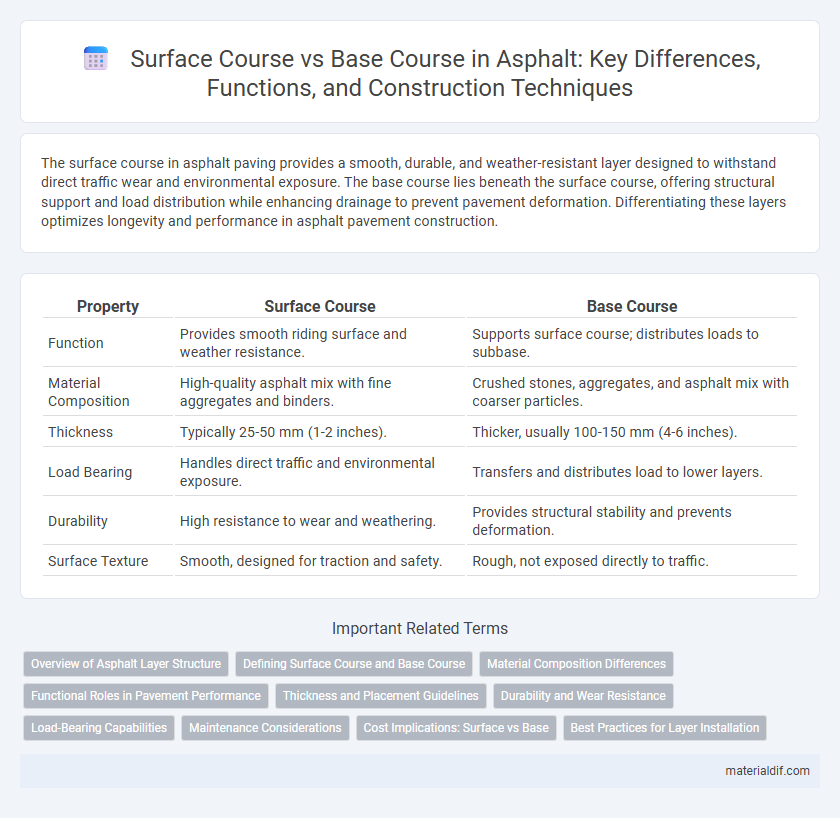The surface course in asphalt paving provides a smooth, durable, and weather-resistant layer designed to withstand direct traffic wear and environmental exposure. The base course lies beneath the surface course, offering structural support and load distribution while enhancing drainage to prevent pavement deformation. Differentiating these layers optimizes longevity and performance in asphalt pavement construction.
Table of Comparison
| Property | Surface Course | Base Course |
|---|---|---|
| Function | Provides smooth riding surface and weather resistance. | Supports surface course; distributes loads to subbase. |
| Material Composition | High-quality asphalt mix with fine aggregates and binders. | Crushed stones, aggregates, and asphalt mix with coarser particles. |
| Thickness | Typically 25-50 mm (1-2 inches). | Thicker, usually 100-150 mm (4-6 inches). |
| Load Bearing | Handles direct traffic and environmental exposure. | Transfers and distributes load to lower layers. |
| Durability | High resistance to wear and weathering. | Provides structural stability and prevents deformation. |
| Surface Texture | Smooth, designed for traction and safety. | Rough, not exposed directly to traffic. |
Overview of Asphalt Layer Structure
The asphalt layer structure typically consists of a surface course and a base course, each serving distinct functions in pavement performance. The surface course is designed to provide a smooth, durable, and skid-resistant riding surface, made from high-quality asphalt mixes with fine aggregates and modifiers to withstand traffic wear and environmental stress. Beneath it, the base course supports load distribution and structural integrity, generally composed of coarser aggregates that enhance strength and drainage, crucial for the overall lifespan and resilience of the pavement system.
Defining Surface Course and Base Course
The surface course of asphalt is the topmost layer designed to provide a smooth, durable riding surface resistant to traffic wear and environmental conditions. The base course lies beneath the surface course, serving as a foundational layer that distributes loads and enhances pavement stability. Both courses consist of specific asphalt mixtures optimized for strength, flexibility, and drainage to ensure the overall integrity and longevity of pavement structures.
Material Composition Differences
Surface course asphalt typically consists of high-quality aggregates combined with polymer-modified bitumen to provide durability, skid resistance, and a smooth finish. In contrast, the base course uses larger, more angular aggregates mixed with standard bitumen or unmodified asphalt to ensure structural support and load distribution. The material composition differences are critical for performance, with the surface course optimized for wear resistance and the base course designed for strength and stability.
Functional Roles in Pavement Performance
The surface course provides a smooth, wear-resistant riding layer that protects underlying pavement layers and distributes traffic loads effectively. The base course supports structural capacity by distributing loads from the surface course to the subgrade while providing drainage and freeze-thaw resistance. Both courses are essential for pavement performance, ensuring durability, load-bearing strength, and resistance to deformation under heavy traffic.
Thickness and Placement Guidelines
Surface course asphalt typically ranges from 1 to 1.5 inches thick and is placed as the top layer to provide smoothness and durability. Base course thickness varies between 3 and 6 inches, serving as the foundational support and ensuring proper load distribution. Placement guidelines emphasize compacting the base course before laying the surface course to prevent settlement and extend pavement lifespan.
Durability and Wear Resistance
Surface courses in asphalt pavement provide superior durability and wear resistance due to their fine aggregate composition and optimized binder content, effectively withstanding traffic loads and environmental stresses. Base courses, designed primarily for structural support, contain coarser aggregates that enhance load distribution but offer less resistance to surface abrasion and weathering. The surface course's enhanced durability ensures prolonged pavement life and reduces maintenance frequency compared to the base course layer.
Load-Bearing Capabilities
The surface course of asphalt pavement provides a smooth, wear-resistant layer designed to withstand traffic abrasion and environmental exposure, while the base course offers critical load-bearing support by distributing vehicle loads to the subgrade. The base course typically consists of coarser aggregate materials with higher structural strength, enhancing pavement durability under heavy loads. Optimizing the thickness and material properties of both courses ensures effective load transfer and extends the service life of the asphalt pavement.
Maintenance Considerations
Surface course requires frequent inspection due to direct exposure to weather and traffic, making timely repairs crucial to prevent cracking and potholes. Base course plays a vital role in load distribution and drainage, so maintenance focuses on ensuring stability and preventing water infiltration to avoid pavement failure. Effective maintenance scheduling for both layers enhances pavement lifespan and minimizes costly rehabilitation.
Cost Implications: Surface vs Base
Surface courses typically incur higher costs per ton compared to base courses due to the use of premium asphalt mixtures designed for durability and aesthetics. Base courses, serving as the foundational layer, require larger volumes but generally consist of lower-grade materials, resulting in overall cost savings for extensive pavement projects. Balancing the thicker base course with a thinner, more expensive surface course optimizes both structural performance and budget efficiency in asphalt pavement construction.
Best Practices for Layer Installation
Applying the surface course with a dense-graded asphalt mix ensures superior durability and skid resistance, vital for high-traffic roads. The base course requires proper compaction of well-graded aggregates to provide structural support and effective load distribution. Optimal layer installation involves controlling moisture content and achieving uniform thickness, which enhances interlayer bonding and extends pavement lifespan.
Surface Course vs Base Course Infographic

 materialdif.com
materialdif.com